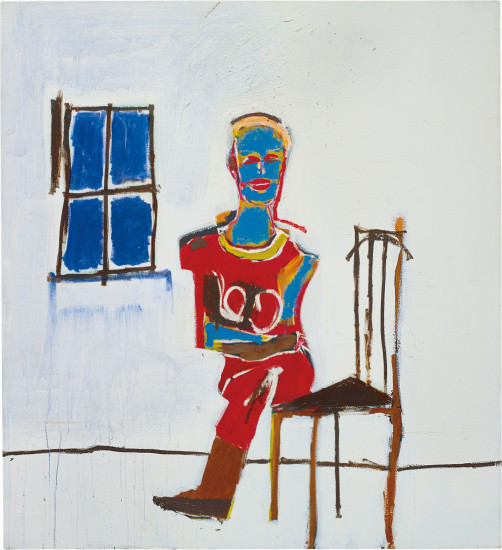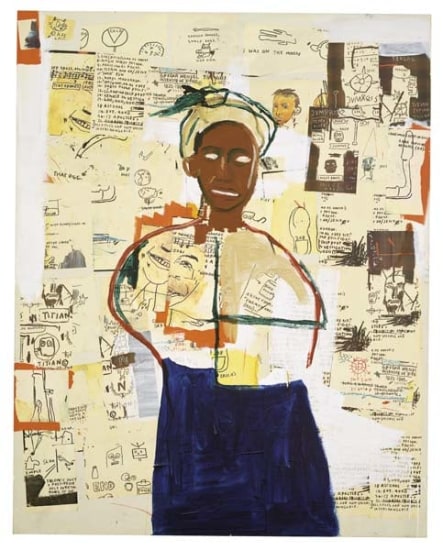Jean-Michel-Basquiat Radium 23 1982-1983 acrylic and oilstick on canvas 94 1/2 x 62 in. (240 x 157.5 cm) This work is accompanied by a certificate of authenticity issued by the Authentication Committee for the Estate of Jean-Michel-Basquiat.
Provenance Sale: Bonhams & Butterfields, Los Angeles, Modern and Contemporary Prints, Paintings & Photographs, May 9, 2001, lot 9068 Ikon Ltd., Santa Monica Private collection, New York Exhibited Santa Monica, Ikon Ltd., Jean-Michel-Basquiat, June 25, 2005 – August 27, 2005 Catalogue Essay As he developed his penchant for dissection–linguistic, anatomical, chromatic, cultural–Jean-Michel Basquiat found his canvases blossom with ever-increasing subject matter and figurative study. If one were to observe the progression of his oeuvre from 1978 until his death in 1988, one would mark the deepening exploration of each motif in each of Basquiat’s works. As he rushed through his impossibly rapid growth to a mature style, Basquiat painted the present lot. Radium 23, 1982-1983 comes at the height of Basquiat’s unprecedented artistic excavations into the human condition; the picture yields boundless treasures of his painterly journey, from the historical pressures that influenced his hand to his mechanical portrayals of the human body’s mysterious machine. Beginning in the late 1970s, Basquiat made somewhat of a name for himself in an artistic partnership with friend Al Diaz. As young graffiti artists, Basquiat and Diaz established themselves as “SAMO”, an antiestablishment, word-based duo that scrawled their art on inner city buildings. Short for “Same Old Shit”, SAMO employed several trademark devices in their graffiti, including original spellings and an almost poetic rhythm to the words that they enshrined. The group developed a cult following in downtown Manhattan, conjuring themes of race, identity, and the absurdity of commercialism and commodification in art. There markable nature of SAMO’s particular style produced art that was as stark as it was beautiful, emphasizing the aesthetic power of the written word. In Radium 23, 1982-1983, the lexicon of text—Radium, Jaw, Flesh— fills the expanse of the canvas with the energy of a young vandal. Not long after Basquiat disbanded SAMO in 1980, he found himself already to be shouldering the label of the enfant terrible of the contemporary art world. Andy Warhol was first exposed to Basquiat’s work at the Times Square Show, an almost makeshift art show in which nearly 100 unknown or modestly recognizable artists decorated the world around them. Basquiat tagged both subway cars and canvasses with his signature urban poetry and unique visual figures, and the two began a fruitful collaboration that would stretch through the 1980s until Warhol’s death in 1987. Yet Basquiat’s major benefit from his appearance in the Times Square Show and from his collaboration with Andy Warhol was his newfound financial independence: he could finally nurture and develop his hand as a painter, which he did rapidly in the next two years. The hand at work was certainly a formidable one in terms of its influences. Jean-Michel-Basquiat bore the weight of an enormous cultural heritage that include both the Voodou tradition of Haiti (his father’s homeland) and the Catholic tradition of Puerto Rico (his mother’s). By the time he had reached ten, Basquiat was already trilingual, speaking Spanish, French, and English in complete fluency. It is almost as if Basquiat’s three languages are indications of his artistic lineage as well. The French Impressionists Rousseau and Gaugin make frequent appearance in scholarship concerning Basquiat—their portraits of indigenous cultures prime for comparison with Basquiat’s Voodou figures and inclusions of masks in his paintings. Basquiat also finds commonality with Picasso; his cubist stylings seem to prefigure the radical, multi-dimensional forms of Basquiat’s own figures. Basquiat’s intellectual life, it seems, was simply born to paint for a new generation of multi-cultural artists. Basquiat’s natural talent comes to us in full force in Radium 23, 1982-1983. Apart from its immense size, the painting’s most striking aspect is, first and foremost, the dominance of orange and bright
Jean-Michel-Basquiat Radium 23 1982-1983 acrylic and oilstick on canvas 94 1/2 x 62 in. (240 x 157.5 cm) This work is accompanied by a certificate of authenticity issued by the Authentication Committee for the Estate of Jean-Michel-Basquiat.
Provenance Sale: Bonhams & Butterfields, Los Angeles, Modern and Contemporary Prints, Paintings & Photographs, May 9, 2001, lot 9068 Ikon Ltd., Santa Monica Private collection, New York Exhibited Santa Monica, Ikon Ltd., Jean-Michel-Basquiat, June 25, 2005 – August 27, 2005 Catalogue Essay As he developed his penchant for dissection–linguistic, anatomical, chromatic, cultural–Jean-Michel Basquiat found his canvases blossom with ever-increasing subject matter and figurative study. If one were to observe the progression of his oeuvre from 1978 until his death in 1988, one would mark the deepening exploration of each motif in each of Basquiat’s works. As he rushed through his impossibly rapid growth to a mature style, Basquiat painted the present lot. Radium 23, 1982-1983 comes at the height of Basquiat’s unprecedented artistic excavations into the human condition; the picture yields boundless treasures of his painterly journey, from the historical pressures that influenced his hand to his mechanical portrayals of the human body’s mysterious machine. Beginning in the late 1970s, Basquiat made somewhat of a name for himself in an artistic partnership with friend Al Diaz. As young graffiti artists, Basquiat and Diaz established themselves as “SAMO”, an antiestablishment, word-based duo that scrawled their art on inner city buildings. Short for “Same Old Shit”, SAMO employed several trademark devices in their graffiti, including original spellings and an almost poetic rhythm to the words that they enshrined. The group developed a cult following in downtown Manhattan, conjuring themes of race, identity, and the absurdity of commercialism and commodification in art. There markable nature of SAMO’s particular style produced art that was as stark as it was beautiful, emphasizing the aesthetic power of the written word. In Radium 23, 1982-1983, the lexicon of text—Radium, Jaw, Flesh— fills the expanse of the canvas with the energy of a young vandal. Not long after Basquiat disbanded SAMO in 1980, he found himself already to be shouldering the label of the enfant terrible of the contemporary art world. Andy Warhol was first exposed to Basquiat’s work at the Times Square Show, an almost makeshift art show in which nearly 100 unknown or modestly recognizable artists decorated the world around them. Basquiat tagged both subway cars and canvasses with his signature urban poetry and unique visual figures, and the two began a fruitful collaboration that would stretch through the 1980s until Warhol’s death in 1987. Yet Basquiat’s major benefit from his appearance in the Times Square Show and from his collaboration with Andy Warhol was his newfound financial independence: he could finally nurture and develop his hand as a painter, which he did rapidly in the next two years. The hand at work was certainly a formidable one in terms of its influences. Jean-Michel-Basquiat bore the weight of an enormous cultural heritage that include both the Voodou tradition of Haiti (his father’s homeland) and the Catholic tradition of Puerto Rico (his mother’s). By the time he had reached ten, Basquiat was already trilingual, speaking Spanish, French, and English in complete fluency. It is almost as if Basquiat’s three languages are indications of his artistic lineage as well. The French Impressionists Rousseau and Gaugin make frequent appearance in scholarship concerning Basquiat—their portraits of indigenous cultures prime for comparison with Basquiat’s Voodou figures and inclusions of masks in his paintings. Basquiat also finds commonality with Picasso; his cubist stylings seem to prefigure the radical, multi-dimensional forms of Basquiat’s own figures. Basquiat’s intellectual life, it seems, was simply born to paint for a new generation of multi-cultural artists. Basquiat’s natural talent comes to us in full force in Radium 23, 1982-1983. Apart from its immense size, the painting’s most striking aspect is, first and foremost, the dominance of orange and bright

.jpg)









Try LotSearch and its premium features for 7 days - without any costs!
Be notified automatically about new items in upcoming auctions.
Create an alert